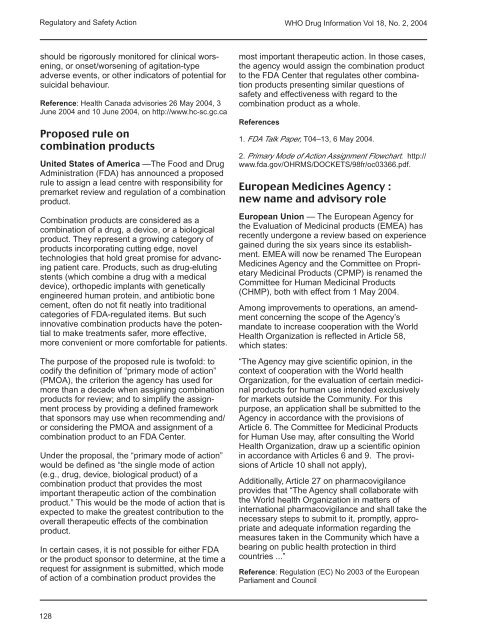WHO Drug Information Vol. 18, No. 2, 2004 - World Health ...
WHO Drug Information Vol. 18, No. 2, 2004 - World Health ...
WHO Drug Information Vol. 18, No. 2, 2004 - World Health ...
Create successful ePaper yourself
Turn your PDF publications into a flip-book with our unique Google optimized e-Paper software.
Regulatory and Safety Action<br />
should be rigorously monitored for clinical worsening,<br />
or onset/worsening of agitation-type<br />
adverse events, or other indicators of potential for<br />
suicidal behaviour.<br />
Reference: <strong>Health</strong> Canada advisories 26 May <strong>2004</strong>, 3<br />
June <strong>2004</strong> and 10 June <strong>2004</strong>, on http://www.hc-sc.gc.ca<br />
Proposed rule on<br />
combination products<br />
United States of America —The Food and <strong>Drug</strong><br />
Administration (FDA) has announced a proposed<br />
rule to assign a lead centre with responsibility for<br />
premarket review and regulation of a combination<br />
product.<br />
Combination products are considered as a<br />
combination of a drug, a device, or a biological<br />
product. They represent a growing category of<br />
products incorporating cutting edge, novel<br />
technologies that hold great promise for advancing<br />
patient care. Products, such as drug-eluting<br />
stents (which combine a drug with a medical<br />
device), orthopedic implants with genetically<br />
engineered human protein, and antibiotic bone<br />
cement, often do not fit neatly into traditional<br />
categories of FDA-regulated items. But such<br />
innovative combination products have the potential<br />
to make treatments safer, more effective,<br />
more convenient or more comfortable for patients.<br />
The purpose of the proposed rule is twofold: to<br />
codify the definition of “primary mode of action”<br />
(PMOA), the criterion the agency has used for<br />
more than a decade when assigning combination<br />
products for review; and to simplify the assignment<br />
process by providing a defined framework<br />
that sponsors may use when recommending and/<br />
or considering the PMOA and assignment of a<br />
combination product to an FDA Center.<br />
Under the proposal, the “primary mode of action”<br />
would be defined as “the single mode of action<br />
(e.g., drug, device, biological product) of a<br />
combination product that provides the most<br />
important therapeutic action of the combination<br />
product.” This would be the mode of action that is<br />
expected to make the greatest contribution to the<br />
overall therapeutic effects of the combination<br />
product.<br />
In certain cases, it is not possible for either FDA<br />
or the product sponsor to determine, at the time a<br />
request for assignment is submitted, which mode<br />
of action of a combination product provides the<br />
128<br />
<strong>WHO</strong> <strong>Drug</strong> <strong>Information</strong> <strong>Vol</strong> <strong>18</strong>, <strong>No</strong>. 2, <strong>2004</strong><br />
most important therapeutic action. In those cases,<br />
the agency would assign the combination product<br />
to the FDA Center that regulates other combination<br />
products presenting similar questions of<br />
safety and effectiveness with regard to the<br />
combination product as a whole.<br />
References<br />
1. FDA Talk Paper, T04–13, 6 May <strong>2004</strong>.<br />
2. Primary Mode of Action Assignment Flowchart. http://<br />
www.fda.gov/OHRMS/DOCKETS/98fr/oc03366.pdf.<br />
European Medicines Agency :<br />
new name and advisory role<br />
European Union — The European Agency for<br />
the Evaluation of Medicinal products (EMEA) has<br />
recently undergone a review based on experience<br />
gained during the six years since its establishment.<br />
EMEA will now be renamed The European<br />
Medicines Agency and the Committee on Proprietary<br />
Medicinal Products (CPMP) is renamed the<br />
Committee for Human Medicinal Products<br />
(CHMP), both with effect from 1 May <strong>2004</strong>.<br />
Among improvements to operations, an amendment<br />
concerning the scope of the Agency’s<br />
mandate to increase cooperation with the <strong>World</strong><br />
<strong>Health</strong> Organization is reflected in Article 58,<br />
which states:<br />
“The Agency may give scientific opinion, in the<br />
context of cooperation with the <strong>World</strong> health<br />
Organization, for the evaluation of certain medicinal<br />
products for human use intended exclusively<br />
for markets outside the Community. For this<br />
purpose, an application shall be submitted to the<br />
Agency in accordance with the provisions of<br />
Article 6. The Committee for Medicinal Products<br />
for Human Use may, after consulting the <strong>World</strong><br />
<strong>Health</strong> Organization, draw up a scientific opinion<br />
in accordance with Articles 6 and 9. The provisions<br />
of Article 10 shall not apply),<br />
Additionally, Article 27 on pharmacovigilance<br />
provides that “The Agency shall collaborate with<br />
the <strong>World</strong> health Organization in matters of<br />
international pharmacovigilance and shall take the<br />
necessary steps to submit to it, promptly, appropriate<br />
and adequate information regarding the<br />
measures taken in the Community which have a<br />
bearing on public health protection in third<br />
countries ...”<br />
Reference: Regulation (EC) <strong>No</strong> 2003 of the European<br />
Parliament and Council

















